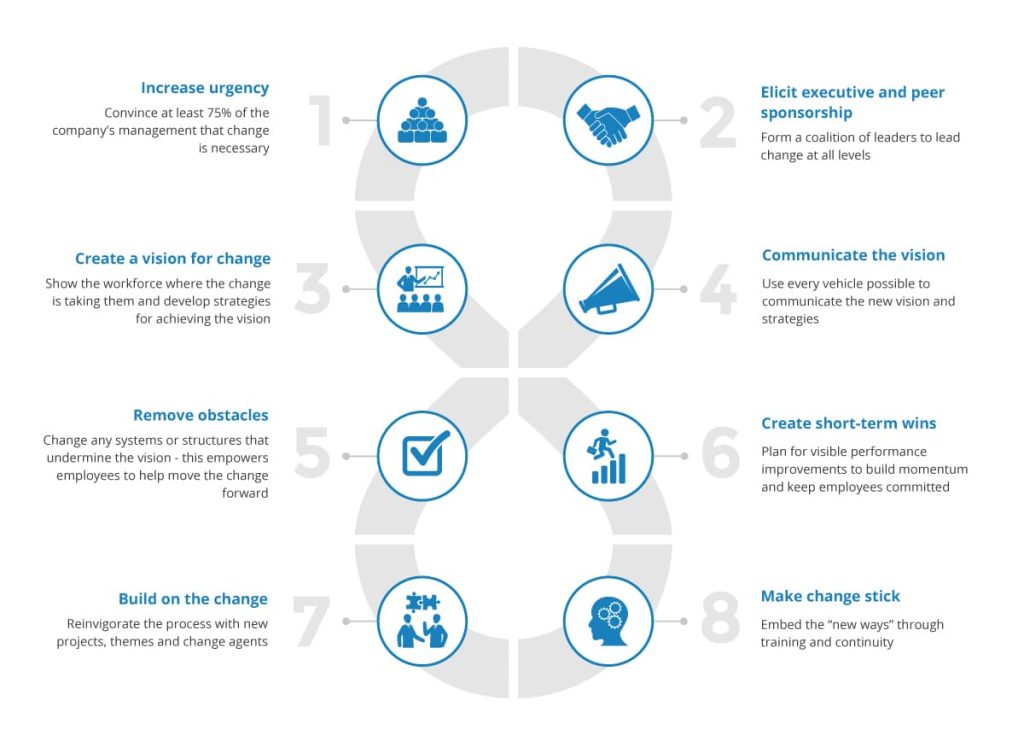The manufacturing industry is in a constant state of change. Digital transformation, supply chain disruptions and increased global competition are pushing companies to evolve and focus on operational excellence to achieve business sustainability.
Implementing change in an organization, however, is often a challenge as people may feel uncomfortable about the change and how it will impact them. Whether you are considering small changes to a few processes or large, sweeping change that transforms an organization, good leadership can make the difference between success and failure.
As a leader, you need to pay special attention to the human side of change management. You need to convince your people that change is necessary, and find ways to keep them motivated and engaged throughout the change process. It requires a culture change where employees think, act and behave differently to align with the new direction. But your people are only human and they may demonstrate some level of resistance. You’ll need to diffuse conflicts, overcome any other obstacles and mobilize your people to achieve great results.
Implement change with Kotter’s eight-step process
How do you implement change in a way that gets employee buy-in and ensures overall success? John Kotter, a professor at Harvard Business School, best-selling author and world-famous change expert, developed an eight-step change process in his book, Leading Change.
Kotter’s 8-Step Process for Leading Change is an award-winning methodology that has identified and extracted the success factors for leading change in an organization. The process is based on four decades of observations of numerous leaders and organizations as they were managing change or executing their strategies.

Download the infographic of Kotter’s 8 steps for leading change and create a blueprint for a successful change initiative.
Three distinct phases of a change initiative
Kurt Lewin (another recognized change expert) and John Kotter have suggested three distinct phases in any change initiative – and these are incorporated in Kotter’s eight-step change model discussed further below. The three phases are:
- Unfreeze the current situation and mindset
- Develop new behaviors, values and attitudes (transition) through deliberate action
- Cement the new ‘‘as is’’ and anchor the change (freeze)
Ashley Braganza, Radical Process Change
Kotter’s eight-step process of change
| Kotter’s eight steps are: | |
| 1. Increase urgency | This is about convincing a large proportion of the workforce (Kotter recommends 75% of the company’s management) that the change is necessary. Have an honest discussion about the changes in technology, the marketplace and increased competition, and give all stakeholders a chance to voice their concerns. This is an important first step, so spend some time building urgency before moving onto the next step. |
| 2. Elicit executive and peer sponsorship | Form a guiding coalition of leaders outside of the established hierarchy. This coalition will work together as a diverse team of change leaders at all levels of the organization who support you in implementing your vision. |
| 3. Create a vision for change | Show everyone how the future will be different from the past. People want to know why you’re asking them to do something, and this becomes easier when they can see for themselves what you’re trying to achieve. You can then develop strategies for executing the vision. |
| 4. Communicate the vision | How you communicate the vision will determine your success. Use every vehicle possible to communicate the new vision and strategies, and teach new behaviors through the guiding coalition. Communicate the vision regularly and powerfully because you’ll be competing with lots of other information that gets communicated daily within an organization. |
| 5. Remove obstacles | Change any systems or structures that seriously undermine the vision. Remove obstacles such as inefficient processes as this will empower employees to help move the change forward. They can focus on working across silos and executing your vision. Be sure to recognize and reward people’s efforts along the way. |
| 6. Create short-term wins | Build momentum for your vision with short-term wins as the vision may ultimately take some time to achieve. These short-term targets must be achievable to avoid undermining the value of the vision, so select these projects carefully. Success in the short term motivates participants and can also help to oppose any critics of the vision. |
| 7. Build on the change | The short-term wins are stepping stones, not an end in themselves. Build on the change by analyzing what went well after each success. Keep looking for improvements and set even more ambitious targets that build on the momentum from the short-term wins. You can also keep things fresh by bringing new change agents into your guiding coalition. |
| 8. Make change stick | Articulate the connections between the new behaviors and corporate success, and embed the “new ways” through training and continuity. For this to succeed, you will have had to have analyzed the organization and neutralized opposing forces early in the design phase of the change initiative. |
Successfully leading your people through change may seem like a daunting task at first. But with a proven methodology such as Kotter’s eight-step process, leaders can steer the organization and its people to achieve unimaginable results.
